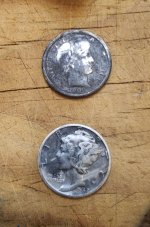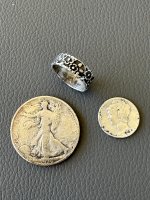Jeffro
Silver Member
What's interesting about this story to me is this area is one of my haunts- 
http://www.losttreasure.com/latestissue/featuredstory.cfm
Treasure News
By Anthony M. Belli
Oregon Treasure Hunter Recovers Pistol That Pre-Dates Lewis & Clark
SWEET HOME, Ore.--What started out as a prospecting trip along the banks of Quartzville Creek for one Oregon man quickly developed in to a treasure hunt. Clint McCraven, 43, of Sweet Home, Oregon, a welder by trade, had slipped out of the house early that morning leaving his sleeping wife behind. He headed off for “the woods” armed with his White’s Electronic Gold Master III to enjoy some well earned time off by prospecting for nugget gold. What he found wasn’t gold but an ancient flintlock pistol and in reasonably good condition.
“I picked up the pistol in three pieces all within a 50 to 60 yard area,” said McCraven. His detector had been sounding off pretty frequently but all he’d found up to that point was garbage.
Then his White’s Gold Master reported again and McCraven dug up a trigger guard, another 20 feet beyond he dug up the pistol’s action. Realizing the firearm was a flintlock, McCraven was stunned, then thought perhaps he’d unearthed a kid’s toy replica. He continued the search and another 30 yards further McCraven discovered the barrel and the wood pistol grip nearly intact and in surprisingly good condition.
“The barrel and wood stock were found in a wet clay material along the banks of the creek, which is probably what protected it from further deterioration,” McCraven said.
McCraven explained that the wood stock is very fragile and missing the butt plate. He added that it appears the pistol had been in a fire at one time.
He took the gun to a local firearms expert who advised him the weapon was indeed a flintlock manufactured prior to 1840 and likely pre-dates the arrival of the Lewis & Clark Expedition to the Oregon Territory in 1805. After examining the pistol local historian Melissa Wise said she “believes it to be the oldest find ever from this area.”
Speculation as to the pistol’s original owners range from early trappers working for the Hudson’s Bay Company to an explorer or an Indian who may have traded for it. For McCraven and other local residents, it has become a mystery that McCraven hopes to soon be able to solve. “I’m going back to metal detect this area again, I’d like to find the ramrod,” he said.
McCraven added that he hopes to be able to locate a campsite or other evidence in the immediate vicinity that can tell him more about who might have been in the area and when.
McCraven purchased his White’s Gold Master III about a year ago and considers himself a “newbie” to the hobby. “Most of what I’ve found hasn’t been of real value, but I have found a lot of old nails, pieces of cable, .22 casings and a ton of fishing sinkers,” he added.
McCraven plans to turn the find over to a friend at the University of Oregon to be studied and preserved. He hopes by doing so he will learn more about this ancient artifact and perhaps something about how it came to be on the banks of Quartzville Creek.

http://www.losttreasure.com/latestissue/featuredstory.cfm
Treasure News
By Anthony M. Belli
Oregon Treasure Hunter Recovers Pistol That Pre-Dates Lewis & Clark
SWEET HOME, Ore.--What started out as a prospecting trip along the banks of Quartzville Creek for one Oregon man quickly developed in to a treasure hunt. Clint McCraven, 43, of Sweet Home, Oregon, a welder by trade, had slipped out of the house early that morning leaving his sleeping wife behind. He headed off for “the woods” armed with his White’s Electronic Gold Master III to enjoy some well earned time off by prospecting for nugget gold. What he found wasn’t gold but an ancient flintlock pistol and in reasonably good condition.
“I picked up the pistol in three pieces all within a 50 to 60 yard area,” said McCraven. His detector had been sounding off pretty frequently but all he’d found up to that point was garbage.
Then his White’s Gold Master reported again and McCraven dug up a trigger guard, another 20 feet beyond he dug up the pistol’s action. Realizing the firearm was a flintlock, McCraven was stunned, then thought perhaps he’d unearthed a kid’s toy replica. He continued the search and another 30 yards further McCraven discovered the barrel and the wood pistol grip nearly intact and in surprisingly good condition.
“The barrel and wood stock were found in a wet clay material along the banks of the creek, which is probably what protected it from further deterioration,” McCraven said.
McCraven explained that the wood stock is very fragile and missing the butt plate. He added that it appears the pistol had been in a fire at one time.
He took the gun to a local firearms expert who advised him the weapon was indeed a flintlock manufactured prior to 1840 and likely pre-dates the arrival of the Lewis & Clark Expedition to the Oregon Territory in 1805. After examining the pistol local historian Melissa Wise said she “believes it to be the oldest find ever from this area.”
Speculation as to the pistol’s original owners range from early trappers working for the Hudson’s Bay Company to an explorer or an Indian who may have traded for it. For McCraven and other local residents, it has become a mystery that McCraven hopes to soon be able to solve. “I’m going back to metal detect this area again, I’d like to find the ramrod,” he said.
McCraven added that he hopes to be able to locate a campsite or other evidence in the immediate vicinity that can tell him more about who might have been in the area and when.
McCraven purchased his White’s Gold Master III about a year ago and considers himself a “newbie” to the hobby. “Most of what I’ve found hasn’t been of real value, but I have found a lot of old nails, pieces of cable, .22 casings and a ton of fishing sinkers,” he added.
McCraven plans to turn the find over to a friend at the University of Oregon to be studied and preserved. He hopes by doing so he will learn more about this ancient artifact and perhaps something about how it came to be on the banks of Quartzville Creek.




